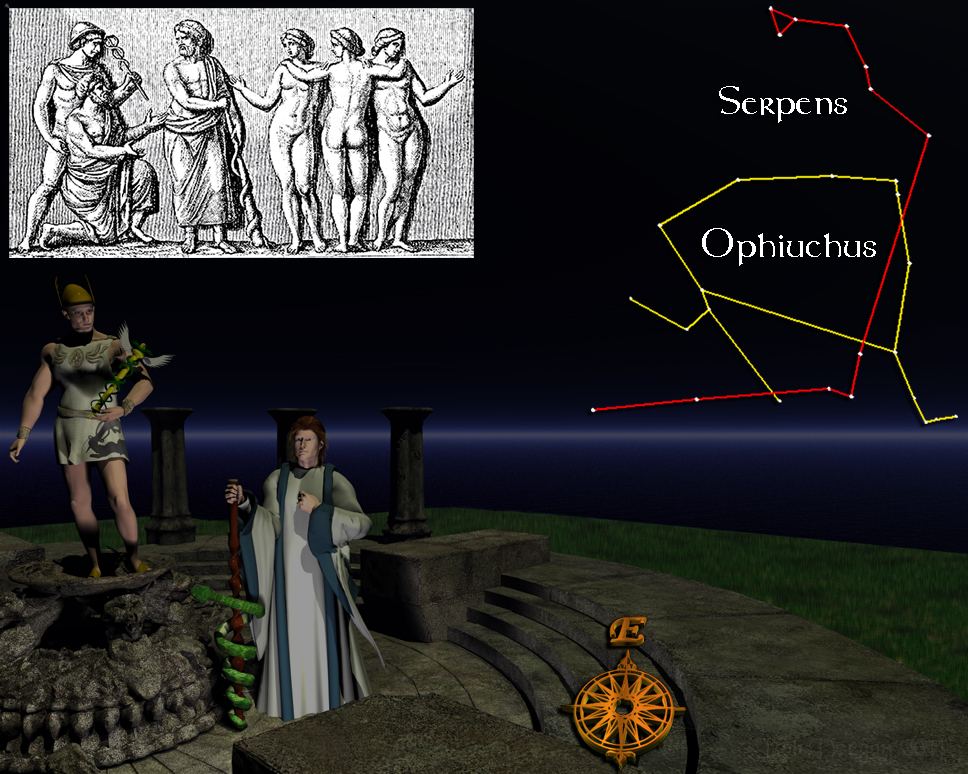
For the week including May 13, 2011

SERPENTS AND STAFFS
If you look toward the east around 10pm, you will see the large constellation of Ophiuchus, the Serpent Bearer, spread across the horizon. Ophiuchus is an age-old constellation from the Greeks. It represents Asclepius, a son of Apollo, who invented medicine. Serpens, the snake he holds in his arms, is a symbol of restored life. At the time, snakes were thought to renew their lives whenever they shed their skins. This constellation is believed to be an abstraction of the symbol of medicine, a serpent entwined on a staff called an asklepian. But, wait a moment; isn’t the symbol of medicine two snakes on a winged staff called a caduceus? After all, we see it a lot wherever medical services are provided, so it must be right. Well, actually no, the caduceus never had anything to do with medicine and its current misuse as a medical symbol is still the subject of cocktail-controversy among doctors.
In the classic Hippocratic Oath, new doctors swore their vocation “by Apollo Physician and Asclepius and Hygieia and Panaceia [daughters of Asclepius – Hygiene and All Healing]”. Ruins of asklepions, early hospitals and medical schools, with staff-and-snake carvings can still be visited in Greece. The caduceus actually belonged to Hermes, more familiar in his Roman version as the god Mercury. Mercury was the god of commerce and travel. He also conducted departed souls to the underworld and didn’t take kindly to Asclepius’ intervention. When Mercury appeared at your door with his caduceus, your number was supposed to be up. Our word caducity still refers to impending and inescapable death.The blurring of the lines between profitable commerce and healing is not new, but the blurring of these symbols surely is. In the engraving of an ancient Roman work at upper-left, a merchant pleads a business enterprise with Asclepius reasoning that the sick will pay any price to get well. He is backed by the commerce-god Mercury holding a caduceus. Asclepius, grasping the asklepian of medicine and flanked by the moral Graces, shuns the merchant and the deal.
It wasn’t until the mid-1800s when a British publisher named John Churchill slapped his company’s commerce logo on medical texts sold in the United States that things really got out of hand. Some American doctors, who were a bit hazy about the symbol of their profession, saw the caduceus logo and mistook it for what they did for a living. Besides, two snakes on a staff were better than one and the wings were really neat looking. One of these doctors, Captain Frederick Reynolds petitioned the Army to have a gold caduceus established as the badge of military doctors. Its adoption in 1902 spread the misidentification throughout the country.
Although the American Medical Association holds the asklepian as medicine’s symbol, the caduceus will probably be around for quite some time. Maybe the gods of commerce are still trying to have their way. It reminds me that hundreds of years ago, the island of San Juan with its town, Puerto Rico (“Rich Port”) was publicized as the island of Puerto Rico with a capitol of San Juan in order to attract European investors to the exploration of the territory.
Unless otherwise indicated, all content of this web site is the copyright of Robert Deegan and all rights are reserved.
For more information, or to comment, please contact: Bob@NightSkies.org